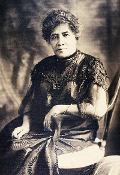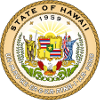The Making of the 50 States: Hawaii
In 1875, Hawaii and the U.S. negotiated a treaty of reciprocity that, when renewed in 1887, gave the U.S. the sole right to establish a naval base at Pearl Harbor, on the island of Oahu. Also in that year, a group of non-Hawaiians rebelled against the government and wrote their own constitution. The Hawaiian Patriotic League, as it was known, had the backing of the Hawaiian militia, and so the king, Kalākaua, was forced to agree to the terms of the new constitution, which curtailed the powers of the throne. This became known as the Bayonet Constitution. Another rebellion the following year sought to replace Kalākaua with his sister, Princess Lili'uokalani, in a coup. The king, who had the support of the militia this time, discovered the plot before it could be carried out and exiled the leader of the rebellion, Robert Wilcox. 
The last monarch on the Hawaiian throne was Queen Lili'uokalani, who succeeded Kalā in 1891, after he died on a trip to the U.S. By this time, many Hawaii businesses were losing revenue at the hands of American interests. Seeking to restore some of the power that her brother had given up in the Bayonet Rebellion, she persuaded the parliament to draw up a new constitution, which effectively made her an absolute monarch. A group of citizens formed a Committee of Safety (led by Minister of the Interior Lorrin Thurston, who had written the Bayonet Constitution), which issued a proclamation that abolished the monarchy and set up a provisional government. Also on the Committee of Safety were legislators, officers in her government, and a Supreme Court justice. The Committee of Safety had weapons on their side, even if a majority of the people living in rural areas supported the queen. Lili'uokalani stepped down under protest and appealed to the U.S. Government for help. The response, after the arrival of the U.S. Military in Hawaii and an initial plan for annexation was shelved, was the formation of the Republic of Hawaii, with Sanford B. Dole as president. After a plan to reclaim her throne unraveled, Queen Lili'uokalani promised no further agitation and took an oath of allegiance to the republic. Congress annexed Hawaii in 1898 and created the Territory of Hawaii in 1900. The following year, James Dole established the Hawaiian Pineapple Company. Pineapples, which were first brought to Hawaii in 1813, became a booming business as well in the early 20th Century. 
During World War II, Japanese forces attacked Pearl Harbor, causing a large number of deaths and a large amount of destruction. The United States entered the war the following day and placed Hawaii under martial law. Pearl Harbor was a prime location for U.S. naval activity for the rest of the war. 
The first proposal for Hawaii statehood came in 1937; Congress rejected it. In the 1940s and 1950s, Hawaii suffered a number of nonviolent strikes and protests. A postwar boom in tourism, with accompanying boosts in construction (particularly of luxury hotels), also helped Congress finally agree to welcome Hawaii into the Union. Hawaii became the 50th state on Aug. 21, 1959. First page > In the Beginning > Page 1, 2 |
|
Social Studies for Kids
copyright 2002–2026
David White




